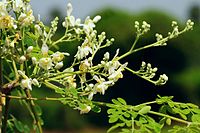
Photo from wikipedia
Abstract This study was designed to examine the effect of operating conditions on essential oil composition and antioxidant activity of coriander cakes. Twenty-nine components were determined in essential oils, which… Click to show full abstract
Abstract This study was designed to examine the effect of operating conditions on essential oil composition and antioxidant activity of coriander cakes. Twenty-nine components were determined in essential oils, which were mostly alcohol monoterpenes. The highest essential oil yields (0.11%) were obtained by the nozzle diameter of 5 mm. The main components of cake essential oil linalool, γ-terpinene, geranyl acetate, linalyl acetate and camphor showed significant variations with different nozzle diameter. The total phenol contents and condensed flavonoid contents varied between different nozzle diameters; the highest values obtained of small diameters (5 and 6 mm). Significant differences were also found in total tannin contents among different nozzle diameters. The total phenol contents decreased significantly ( p The screening of antioxidant activity of the different coriander cakes using the di(phenyl)-(2,4,6-trinitrophenyl) iminoazanium radical (DPPH) assay showed an appreciable reduction of the stable radical DPPH, although small nozzle diameter was the most efficient method with an IC 50 reached of 55 μg/ml as compared with bigger diameter (IC 50 = 88 μg/ml). All the extracts had lower β-carotene bleaching activity than that of synthetic antioxidant BHA and BHT. Coriander cake extracts presented a very low reducing power ability (EC 50 ≈ 700 μg/ml) compared to ascorbic acid (EC 50 = 40 μg/ml).
Journal Title: Arabian Journal of Chemistry
Year Published: 2019
Link to full text (if available)
Share on Social Media: Sign Up to like & get
recommendations!